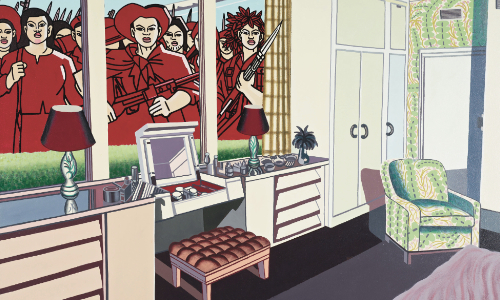Review: The World Goes Pop

The World Goes Pop could have as its unofficial tagline: “There’s More to Pop Art Than Tins of Soup.” It sets out to dispel the myth that pop art is a US-centric, male-centric, consumerist-centric art form. This, of course, is a rather easy thing to do, especially when the term “pop art” is used in such a broad sense (if it’s brightly coloured and made between 1955 and 1975, it counts, okay?).
The resulting exhibition is as loud and saturated as the works it displays. Walls are daubed in primary colours; video installations chirrup, sirens blare and heartbeats echo from distant rooms; sculptures dangle from the ceiling and rise up from the ground.
It collects mostly obscure works (some haven’t been seen since their first airing 45 years ago), few of which originate in the US. The high-point is a room dedicated to anti-war pieces, using familiar tropes (catalogue models are painted over war scenes, for instance) to directly rail against conflict. Feminism features heavily – an entire room is dedicated to Czech artist Jana Želibská’s lurid pink silhouettes of dancers with mirrors replacing their genitals, placing your own face at the centre of your voyeurism. Kiki Kogelnik’s latex figures hanging from coat hangers, meanwhile, is one of the more interesting takes on body objectification. Other diversions, however, feel like unnecessary padding – rooms dedicated to folk pop art and Romanian artist Cornel Brudaşcu, for example, add little of value.
Some of the meaning of individual pieces is inevitably lost amid the overall cacophony. At times The World Goes Pop feels like one big installation piece: loud, bright and attention-grabbing. It’s consistently engaging if not always particularly enlightening; one could argue that’s symptomatic of pop-art itself.
Towards the end of the exhibition are torn and blackened reproductions of Lichtenstein’s Whaam! and a Warhol soup tin, by Russian artists Komar and Melamid. They were intended as a pithy response to the Cold War threat of nuclear armageddon, but in this context they feel like a playful two fingers by the curators to those who think pop-art begins and ends in New York.
First published in City A.M.

